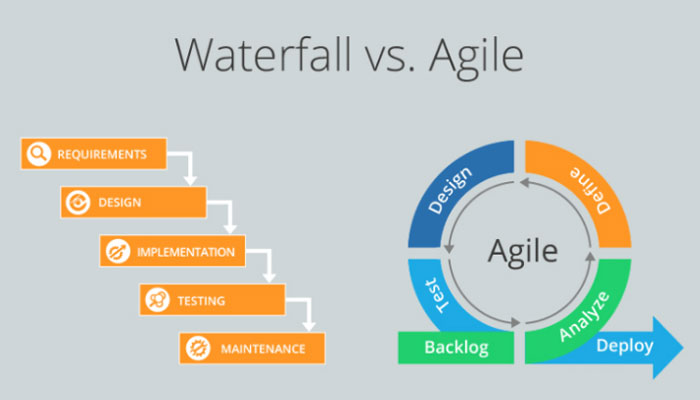Agile Methodology: Any framework used to structure, plan, and control the development process of a system is its methodology for developing it. Over the years, several of those frameworks have evolved. Each has its strengths and its weaknesses. A number of these are available to developers. Some of these are Scrum, Waterfall, Lean and Agile methodologies.
The companies have some options to choose from for their projects. Although the methodology of Agile has proven to be very effective in larger organizations, the dynamics of communication and cooperation in a start-up are very different from that of a larger organization. So does the Agile methodology also work for start-ups? Let’s figure it out.
What is Agile Methodology?

Agile Methodology is a method of development in which needs and solutions evolve through the collaborative effort in cross-functional teams. Its approach aligns project and product development with customer requirements and overall company objectives.
It is a methodology based on the development of iterativeness. This process promotes frequent inspection and adaptation which helps to deliver high-quality software quickly. Agile methodology is developed for products and projects that require flexibility and speed, meaning almost every product and project that is currently being managed.
How does Agile Methodology help start-ups?
Quickly adapts to Organizational Change
The agile methodology provides a swift response to organizational change. It assists in the dynamic characteristics of business processes and helps manage changing project requirements. One of the Agile Manifesto’s important principles stresses welcoming changing requirements, even if they are late in a project.
The agile methodology allows both customers and stakeholders to gain feedback sooner than later on the latest iterations and new features. Stakeholders can rethink requirements and features, add new ones and they can be quickly followed by the development teams.
Development teams innovate and take risks, as they are constantly in the loop, according to the customer requirements. Quickly adapting to the changes saves time and resources which helps start-ups to maintain themselves. It is the best environment methodology that is constantly changing. Start-ups adjust and readjust their sails constantly to get the headwind.
Encourages Individual Interaction
The agile methodology mostly depends on the meetings, its stand-ups. Every member of the team has to come prepared and answer these three questions.
- What have you done since the last meeting?
- What are you working on right now, until the next meeting?
- What’s got in your way from efficiently doing your job?
The answers to these questions largely describe the scope of the projects, profiles, timetables, and specify the individual role of everyone in it. Anybody knows who’s responsible for what.
This eliminates the chances of any kind of duplication of work and clarifies confusion among team members that ensure good communication if any.
Formal structures in a large organization with large teams – this process might not work effectively, but it works magnificently in start-ups.
3. Installs The Culture of Working Cohesively
Daily interacting with your peers to discuss the ongoing projects and collectively ensuring that the projects stay on schedule and track fosters a teamwork-a sense of belonging with a clear sense of responsibility. You will find out your strengths and weaknesses and collectively decide the role that will use your expertise to best advantage.
If you need motivated leaders, you’ll provide the right environment for them. If you need people who will be able to carry the load for the duration it needs to be carried, give them the right support. Better teamwork translates into less waste of resources for start-ups which is important.
Agile Development Boosts Quality
There is no doubt about the fact that the overall software quality is improved by Agile Development. Cross-functional teams do away with bottlenecks through constant communication in agile development. Developers are more dependent on the stakeholders’ quick feedback regarding requirements than on the formal documents prepared months ago. There are immediacy and dynamism in there.
Teams use artifacts such as DoD-The Done Definition to assess whether the list of requirements is complete. The automated testing process identifies developed problems early. Integrations are easy, and the CI concept – Continuous Integration prevents the problems from arising.
Test-driven development ensures the architecture and design are not complex. It is very important for start-ups as an upcoming unit that they stay focused on quality and that agile development helps them to do that.
Saves Time and Effort, Fostering Resourcefulness
The agile methodology ensures that your projects are under-budget, on schedule, and completed without hitches. Start-ups are working on scarce resources. Agile development ensures its resources are used optimally.
Teams are smaller, and they can work functionally across the board. Agile is something of a mind-set. By managing the constraints, it believes in constantly adding value to the product. Feedback from the customers is gathered and the small agile teams then perform work in small sprints all guided by feedback.
The agile methodology provides more transparency in the processes when you compare it with waterfall technology, and the products made reach the customers faster with the aid of sprints (which are short delivery cycles). Project development guided by feedback from customers and iterative cycles ensures less resource wastage.
The best part is that agile development can begin with being a part of the system in a lean start-up but being slowly advantageous, it almost always becomes the entire ecosystem.
Enables Diffusion of Knowledge and Cross-Training AcrossOrganization
Daily meetings, the stand-ins, ensure that everyone knows at any given time what everyone else in the team is working on.
There is knowledge dissemination and sharing the details of the development process with team members even knowing and understanding the parts of the components with which they are not directly associated.
Agile software development techniques such as pair programming where two programmers share a single workstation-one screen, keyboard, and mouse where one programmer takes a driver’s role and the other takes a navigator ‘s role. The driver codes and the navigator provide the project direction. There are plenty of advantages of this agile technique that start-ups can take advantage of.
Better code quality, better coordination, better knowledge dispersion when a mobile app developer that knows everything about a component pair with a developer who is unfamiliar with the component being developed and yes, agile development helps you find alternative and more effective ways to develop applications. Limited resources, a lean start-up benefit when there are cross-functional training and one man is capable of effectively assuming the role of another man with immediacy.
Keeps all the stakeholders in the loop
The founders and key stakeholders are often not a part of the actual process of development. The agile methodology aims to promote sustainable development while ensuring that all stakeholders are in the loop, such as product owners, developers, and users.
Scrum, a part of the agile movement that helps you make that happen. The purpose of scrum instruments such as burndown charts and product backlog charts is to demonstrate progress to all stakeholders, which tells them more than the list showing which features were shipped can tell. All this information is very useful for lean start-up founders who also need to think quickly and decide the course of action quickly.
Final words
Start-ups are looking for a business that is repeatable and scalable. The quicker you find the solution that can be scaled and offered to the markets the better it is for all involved stakeholders. Managing resources is also pretty important.
For start-ups, the agile methodology is the best bet. It provides for faster iterations. It helps in the optimal management of its resources and the business gets on track at the earliest. By adopting agile methodology, start-ups can reduce their costs, keep the teams tightly knit, keep their projects on schedule, and yes, stakeholders get better returns on their investments.
























